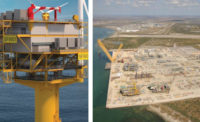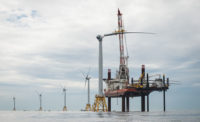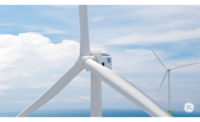Offshore wind projects have taken root in the U.S. Will only experienced European contractors harvest the fruit?
The country's first operating offshore wind farm, off the coast of Block Island, R.I., began contributing energy to the power grid in December 2016. Now, more than 23 offshore wind projects, collectively expected to produce 16,000 MW of power, reportedly are being planned. European engineering, procurement and construction contractors with decades of global experience building offshore wind farms already are moving into the U.S. market.
Can U.S. EPCs sit on the sidelines and cede this market to them?
Some critics have decried President Trump's apparent lack of commitment to renewable energy, but the U.S. Dept. of the Interior has proved to be a willing partner in the development of offshore wind energy.
The recent spike in offshore-wind activity has been fueled largely by a surge of political interest. Some critics have decried President Trump's apparent lack of commitment to renewable energy, but the U.S. Dept. of the Interior has proved to be a willing partner in the development of offshore wind energy.
In March 2017, the Dept. of the Interior leased 122,000 acres off the coast of North Carolina to Avangrid, a subsidiary of Iberdrola, a Spanish company. DOI recently also finalized a lease with a Norwegian company, Statoil, for Long Island, N.Y., waters. The department evidently sees a future for U.S. offshore wind.
According to a spokesperson, the Bureau of Ocean Energy Management currently is receiving annual rent payments of more than $4 million for leases on the Outer Continental Shelf.
Recent state actions also have primed the pump for offshore-wind development.
In August 2016, Massachusetts Gov. Charlie Baker (R) signed a law requiring utilities to procure 1,600 MW of electricity from offshore wind farms by 2026. In May 2017, the Massachusetts Dept. of Energy Resources acted to execute that requirement with a request for proposals for the creation of up to 800 MW of offshore wind. New York Gov. Andrew Cuomo (D) announced that the state would commit to installing 2,400 MW of offshore wind by 2030, furthering his goal that 50% of New York's power will come from renewable-energy resources. To that end, in January 2017, Cuomo approved the South Fork Wind Farm to power 50,000 Long Island homes.
One American company, Deepwater Wind, the Block Island project's developer, now has turned its attention to a new project: the 90-MW, 15-turbine South Fork Wind Farm. Deepwater Wind plans to streamline the process it developed at Block Island, expecting to capitalize on its biggest "lessons learned" to create efficiencies and an offshore-wind supply chain.
For the Block Island project, Deepwater Wind took a novel approach. Rather than contract with onshore-wind and renewable-energy companies, it recruited U.S. offshore oil-and-gas companies that were mired in an industry slump. These companies had a surplus of capacity and, importantly, vessels sitting idle in the Gulf of Mexico. Two Louisiana companies were engaged to build Block Island's foundation and install the project's General Electric turbines.
Deepwater Wind also worked with local Rhode Island companies, which had the opportunity to gain valuable industry experience through their partnership with the offshore construction companies and the experienced European contractors. The Block Island project created 330 jobs in Rhode Island—that is, 330 employees who now have the requisite training and experience to work on future offshore-wind projects.
In fact, Deepwater Wind expects to reap significant efficiency savings in its second, larger offshore-wind-farm development. South Fork's estimated total cost already has decreased 25% since first projections, and it is expected to cost 30% less per unit of energy than Block Island. Deepwater Wind also expects that the turbines will be less costly and that the process for obtaining permits will be more efficient.
With each completed project, the supply chain grows stronger and companies become more efficient, making each successive project more cost-effective and enticing to state governments and utilities.
Falling Wind Energy Costs Predicted
The Dept. of Energy predicts that the cost of offshore wind energy will fall 43% by 2030. As this trend continues, utilities likely will be more inclined to sign power purchase agreements, and governments will have greater incentives to promote offshore wind as a clean energy resource.
Each successful project also increases investor confidence. Deepwater Wind, the U.S. face of offshore wind development, is owned by D.E. Shaw, a hedge fund and private equity firm that manages more than $40 billion in assets. Moreover, both Citigroup and HSBC have expressed interest in financing future projects.
The U.S. offshore wind market is acquiring experience and approaching maturity. State and federal government actions appear to support a long-term plan for offshore wind farm development. With every completed project, production and financing costs will continue to drop.
The question now is, who will reap the rewards of this burgeoning industry? Will European contractors continue winning work from developers of future U.S. offshore wind sites, or will American EPCs rise to the challenge and stake their claim?
Jeffrey Karp is a partner and Zachary Altman is an associate with Boston-based law firm Sullivan & Worcester LLP.





Post a comment to this article
Report Abusive Comment